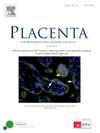The roles of maternal one-carbon metabolism and placental imprinted gene expression in placental development and somatic growth in a longitudinal birth cohort
IF 3
2区 医学
Q2 DEVELOPMENTAL BIOLOGY
引用次数: 0
Abstract
Objectives
One-carbon nutrients and imprinted genes both play critical roles in placental development and somatic growth. We aimed to examine (1) the impact of maternal one-carbon nutrition on placental imprinted gene expression, placental development, and infant growth and (2) interactions between one-carbon nutrients and imprinted genes in placental development and infant growth.
Methods
Women were interviewed prenatally about demographics and their alcohol, smoking, and drug use during pregnancy in a prospective longitudinal cohort study examining developmental effects of prenatal alcohol exposure in Cape Town, South Africa (N = 158). Erythrocyte folate, serum vitamin B12, and plasma choline concentrations were assayed at recruitment. Infant weight and height were assessed at age 2 weeks. Placental histopathology exams and placental expression of 109 imprinted genes (Nanostring) were assessed (n = 65).
Results
In limma tests, women with plasma choline concentrations below the median had lower placental expression of EPS15, IGF2R, LINC00657, SGCE, ZC3H12C, and ZNF264 than women above the median (p < 0.05, FDR<0.10). In regression models adjusted for potential confounders, plasma choline (μM) was associated with larger placental weight (g) (B = 14.0(1.9, 26.2)) and reduced maternal vascular underperfusion (MVU) prevalence (B = −0.07(-0.12, −0.02). Trends were seen for mediation of the relation between choline and MVU by decreased LINC00657, ZC3H12C, and ZNF264 expression. In regression models examining plasma cholineXimprinted gene expression interaction effects, plasma choline modified relations of EPS15, ZC3H12C, and ZNF264 to placental weight and fetal growth.
Conclusions
These findings suggest maternal choline status may impact placental and fetal development, with imprinted genes playing potential mechanistic roles.

纵向出生队列中母体单碳代谢和胎盘印迹基因表达在胎盘发育和体细胞生长中的作用
目的单碳营养物质和印迹基因在胎盘发育和体细胞生长中都起着至关重要的作用。我们旨在研究(1)母体单碳营养对胎盘印迹基因表达、胎盘发育和婴儿生长的影响;(2)单碳营养与印迹基因在胎盘发育和婴儿生长中的相互作用。方法在一项前瞻性纵向队列研究中,研究了南非开普敦产前酒精暴露对发育的影响,对妇女进行了产前人口统计学采访,了解她们在怀孕期间的酒精、吸烟和药物使用情况(N = 158)。招募时测定红细胞叶酸、血清维生素B12和血浆胆碱浓度。在2周龄时评估婴儿体重和身高。评估胎盘组织病理学检查和109个印迹基因(Nanostring)在胎盘中的表达(n = 65)。结果血浆胆碱浓度低于中位数的妇女胎盘中EPS15、IGF2R、LINC00657、SGCE、ZC3H12C和ZNF264的表达低于中位数以上的妇女(p <;0.05, FDR< 0.10)。在校正潜在混杂因素的回归模型中,血浆胆碱(μM)与较大的胎盘重量(g) (B = 14.0(1.9, 26.2))和母体血管灌注不足(MVU)患病率降低(B = - 0.07(-0.12, - 0.02)相关。LINC00657、ZC3H12C和ZNF264的表达降低是胆碱与MVU之间关系的中介。在检验血浆胆碱印迹基因表达互作效应的回归模型中,血浆胆碱修饰EPS15、ZC3H12C和ZNF264与胎盘体重和胎儿生长的关系。结论母体胆碱水平可能影响胎盘和胎儿的发育,印迹基因可能在其中发挥作用。
本文章由计算机程序翻译,如有差异,请以英文原文为准。
求助全文
约1分钟内获得全文
求助全文
来源期刊

Placenta
医学-发育生物学
CiteScore
6.30
自引率
10.50%
发文量
391
审稿时长
78 days
期刊介绍:
Placenta publishes high-quality original articles and invited topical reviews on all aspects of human and animal placentation, and the interactions between the mother, the placenta and fetal development. Topics covered include evolution, development, genetics and epigenetics, stem cells, metabolism, transport, immunology, pathology, pharmacology, cell and molecular biology, and developmental programming. The Editors welcome studies on implantation and the endometrium, comparative placentation, the uterine and umbilical circulations, the relationship between fetal and placental development, clinical aspects of altered placental development or function, the placental membranes, the influence of paternal factors on placental development or function, and the assessment of biomarkers of placental disorders.
 求助内容:
求助内容: 应助结果提醒方式:
应助结果提醒方式:


